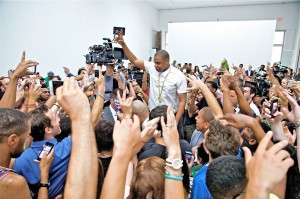Hip-Hop as Performance Art: Jay Z, Appropriation, and Critiques of Whiteness
By Janell Hobson
 At first, I wasn’t sure what to make of Jay Z’s performance of “Picasso Baby,” featured on his new album Magna Carter Holy Grail, which has received much coverage for its innovative release through a Samsung app. Proving to an increasingly skeptical public that he is more than a “corporate rapper,” indeed a “risk-taking” artist pushing hip-hop into different territory, Jay Z has since taken to appropriating performance art when he performed “Picasso Baby” for six hours before a mostly white crowd of art enthusiasts and artists (give and take a few recognizable African American artists like Lorna Simpson and Latina performers like Rosie Perez) at Manhattan’s Pace Gallery. Footage of this performance art was later edited into a music video, directed by Mark Romanek, which made its debut on HBO the night of August 2, 2013.
At first, I wasn’t sure what to make of Jay Z’s performance of “Picasso Baby,” featured on his new album Magna Carter Holy Grail, which has received much coverage for its innovative release through a Samsung app. Proving to an increasingly skeptical public that he is more than a “corporate rapper,” indeed a “risk-taking” artist pushing hip-hop into different territory, Jay Z has since taken to appropriating performance art when he performed “Picasso Baby” for six hours before a mostly white crowd of art enthusiasts and artists (give and take a few recognizable African American artists like Lorna Simpson and Latina performers like Rosie Perez) at Manhattan’s Pace Gallery. Footage of this performance art was later edited into a music video, directed by Mark Romanek, which made its debut on HBO the night of August 2, 2013.
Clearly influenced by iconic performance artist Marina Abramovic – prominently featured in “Picasso Baby” – and her 740-hour one-on-one interactions with audiences in MoMA’s 2010 “The Artist is Present” exhibit, as well as by The National, who performed their song “The Sorrow” for six hours straight in an ongoing loop at MoMA’s PS1 earlier this year, Jay Z also took to performing his song in one-on-one interactions before inviting groups of fans/audiences to surround him and lend him their energy. A fun time to be had by all, right? But does the fun take away from Jay Z’s critical spectacle of hip-hop as “art,” let alone “performance art?”
Aspects of most performance art – whether scripted or unscripted – tend to focus on the artist’s body and that body’s effect on its surrounding environment, including social interactions. So on that level, Jay Z advances a cultural and political commentary on hip-hop – from freestyling to performer/audience interaction – as the epitome of performance art, in which the rapper’s body is central to the racialized and sexualized narratives our culture has circulated about this musical genre. Both Jay Z’s celebrity and performance, predicated on the racial exoticization of his “outlaw” black body (and, thereby, his “transgression” into fine-arts culture), have shaped the conflicting responses from the general public. Those who appreciate high-art culture have deduced that, somehow, the “art world” has sold out to this “crass” display of commercial rap at an enclosed gallery space – as represented by the awkward pas-de-deux of Abramovic and Jay Z. Whereas, the inverse is argued by some of Jay Z’s rap fans who believe it is Jay Z who has “sold out” to the art world, creating a “spectacle” out of hip-hop and his exoticized black body for the sake of cultural validation in the fine arts world.
Of course, this performance is not so simple. After all, wouldn’t Jay Z’s attempts at “cultural validation” of hip-hop have taken place instead at Carnegie Hall, the ultimate space for musical canonization? Jay Z may not be as deeply invested in canonization as he is in the meanings we give to the value of certain art forms.
Indeed, the lyrics to “Picasso Baby” reveal his angst in splurging his newfound wealth on Picassos, Rothkos, Jeff Koons, and Leonardo DaVincis. Deeper analysis reveals the “corporate rapper” highly conscious of how he is to spend his dollars and demonstrate his “evolved” awareness through the spectacle of whiteness. Even here, we may note his desire to subvert white aesthetics when he raps, “Sleeping every night next to Mona Lisa/ The modern day version with better features,” at once re-objectifying his wife and fellow pop star Beyoncé while simultaneously and boldly advancing an aesthetic preference for the black female body. He goes further, reframing an artwork by black graffiti artist Basquiat (with whom he self-identifies) for his daughter Blue Ivy: “Yellow Basquiat in my kitchen corner/Lean on that shit, Blue, you own it.” Art may be a matter of consumption and possession, but here Jay Z insists on organic, lived-in, interactive experience, in which his Basquiat will not just hang on a wall but occupy space, in the highly interactive lived space of a kitchen, leaned on by his toddler daughter no less! Jay Z literally reclaims Basquiat from the art world and puts him back into the street culture from whence he came.
If Jay Z is indeed “Jean Michel [Basquiat] / Surrounded by Warhols,” then the fun-seeking and star-struck art crowd at Pace Gallery is crucial to the performance art itself. When “Picasso Baby”’s lyrics take a darker turn, in which Jay Z reminds us of the continued violence done to the black male body, his multi-millionaire celebrity status notwithstanding – “My hairpin pierce skin, ruptures spleens/ Cracks ribs, go through cribs, and other things” – the audience’s mood doesn’t change with it. There is no comprehension of the message, only the immediate awe and amusement of “the rapper is present.” One art critic, Jerry Saltz, described his encounter with Jay Z as “tribal,” inducing in him a desire to “dance barefoot.”
Such encounters that rely on the spectacle of black bodies recall other performance art moments, including Coco Fusco and Guillermo Gomez Peña’s 1992 “Two Undiscovered Amerindians” and Afro-Swedish artist Makode Linde’s 2012 “Painful Cake.” Both of these controversial performances not only highlighted the spectacle of the exotic, “primitive” Other in high-cultured spaces but also the unaware racial violence enacted on these bodies: from animalistic treatment (the “cage” and feeding bananas to Fusco and Peña) to ritualistic “cutting” (Linde).
While Jay Z’s performance invites more enjoyment from the audience and clearly exhibits his star power, in contrast to the performative violence of the previously mentioned art works, there is still the recurring theme of “authentic blackness” that artists of color are supposed to embody. Because Jay Z is not readily recognizable as a “performance artist” and is responded to by virtue of his celebrity status and his “authentically” black body, few in his audience will recognize his cultural appropriation as an inherent critique of whiteness and its aesthetic institutions. The very nature of exhibiting his freestyle performance for the gallery space raises questions about what constitutes art and art making and who gets to define it. Jay Z now has the financial power to insert himself into that space, but will this encounter urge curators to feature more artists of color in these spaces? Jay Z seems pessimistic even here, when he acknowledges this simple truth: “What’s it gon take for … you to see, I’m the modern day Pablo, Picasso baby.”
This is hardly a display of his braggadocio and more of his awareness of institutionalized racism that limits our definitions and appreciation of art.
http://www.youtube.com/watch?v=xMG2oNqBy-Y
______________________________________________
 Janell Hobson is an associate professor in the Department of Women’s, Gender, and Sexuality Studies at the University at Albany. She has authored two books – Body as Evidence: Mediating Race, Globalizing Gender (2012) and Venus in the Dark: Blackness and Beauty in Popular Culture (2005) – and regularly blogs and writes for Ms. Magazine, including the cover story, “Beyonce’s Fierce Feminism,” in the Ms. Spring 2013 issue.
Janell Hobson is an associate professor in the Department of Women’s, Gender, and Sexuality Studies at the University at Albany. She has authored two books – Body as Evidence: Mediating Race, Globalizing Gender (2012) and Venus in the Dark: Blackness and Beauty in Popular Culture (2005) – and regularly blogs and writes for Ms. Magazine, including the cover story, “Beyonce’s Fierce Feminism,” in the Ms. Spring 2013 issue.




5 Comments